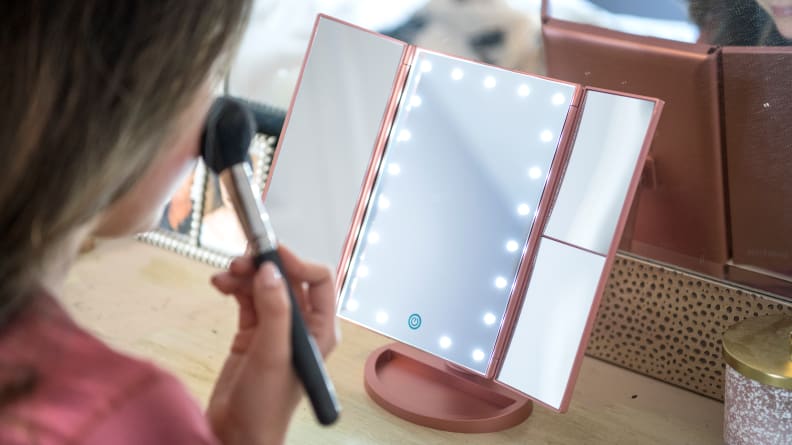Here's how to groom your eyebrows at home
It’s a delicate balance of plucking enough, but not too much.
Products are chosen independently by our editors. Purchases made through our links may earn us a commission.
If social distancing due to the coronavirus (a.k.a., COVID-19) has you embracing overgrown bangs or painting your own nails, you’re not alone. But now that your monthly brow-wax appointment was cancelled and you’re looking, ahem, extra-expressive with fuzzier-than-normal eyebrows, that may be where you draw the line.
To find out how you can groom your eyebrows on your own—without (inadvertently) bringing back the pencil-thin brows of the early 2000s—we consulted Jared Bailey, Benefit Cosmetics’ global brow expert for his best DIY advice.
Step 1: Trim your eyebrow hairs
Every eyebrow hair does not need to be the same length, but if your brows look as though they’re fraying along the top edge, the solution is to trim them. Using a brow brush or spoolie (basically, a clean mascara wand), Bailey says to brush the hair up toward the hairline and out toward the temple. With sharp, fine-pointed cosmetic scissors, trim the tips of the hair that grow past the “mainland” of your brow. Don’t rush the process. If you need to clip one single hair at a time, reset the brow to how you naturally wear them, and then push the hair up again for the next hair, do that! Practice makes perfect.
Everything you need for this step can be found in the Japonesque Pro Performance Brow Grooming Duo, including a spoolie and pair of cosmetic scissors. The spoolie is the perfect size to grab most of your eyebrow hairs in one swoop and the stainless steel scissors are safe to wash after each use.
Get the Japonesque Pro Performance Brow Grooming Duo at Target for $8.99
Step 2: Identify hairs you want removed and assemble your tools

A lighted makeup mirror helps you see each hair clearly.
Another common regrowth issue: Those random hairs that grow way outside your brows, beneath and between them especially. Examine your brows in a well-lit area or with a lighted makeup mirror—either way, your reflective surface should be a regular mirror (called “1x” in mirror-speak). “Using tiny magnifying mirrors should be illegal [when it comes to eyebrow grooming] because you can only see a field of tiny hairs versus the actual shape [of the whole brow] and what it’s doing for your entire face,” Bailey says.
With both brows visible in your mirror, decide which hairs need to be removed. Err on the side of caution and only plan to pluck clear outliers. If you have trouble with this, Bailey recommends filling in the mainland of your eyebrows with a brow pencil. Anything outside of where you’d want to fill in your brows is unnecessary hair and can be tweezed.
Choose tweezers that are fine-tipped and either pointed or slanted and meet perfectly together—this is not the time to scrimp on no-name brands. Japonesque makes a good set of tweezers that includes two pairs. The first has slant tip, which makes it easier to grab thicker hair or several hairs at a time (something you may want to speed things up in between your brows, for example). The other pair has a fine-pointed tip, which may take more practice to use but works well to snag the finest or shortest hairs.
If you don’t already own a lighted makeup mirror, you probably can’t imagine how helpful they are for makeup application and precision tasks like eyebrow grooming. Our favorite is the Glamcor Riki Skinny, which is wireless, has five bright light settings, a large viewing area, and a super-slim packable, portable design. Alternatively, consider our Best Value mirror, the DeWeisn Tri-Fold Lighted Mirror, which features adjustable lights, three magnification options, and the ability to fold for storage or travel, at a lower price.
- Get the Japonesque Pro Performance Tweezer Duo at Target for $7.99
- Get the Glamcor Riki Skinny on Amazon for $195
- Get the DeWeisn Tri-Fold Lighted Mirror on Amazon for $19.98
Step 3: Get to work but pluck with caution
Once you’ve mapped out where you want to take your tweezers, focus on how you pluck. “The most common mistake people make when tweezing is removing the hair in the wrong direction,” Bailey says.
Many people who over-plucked in the past and the hairs never regrew think it’s because they tweezed too often, but Bailey says it’s more likely that they tweezed improperly by going against the grain. “Each brow hair is connected to a tiny blood vessel that keeps it healthy and allows it to grow back when the hair is removed,” Bailey explains. “Once that vessel is ruptured, the hair never returns.”
To avoid damaging the vessel, gently pull your skin taut and pinch the tweezers around the base of the hair without grabbing any of your skin. If you pull from the end of your hair, you may just break the hair instead of removing it. Then pull in the direction that the hairs grow out from the skin.
Step 4: Clean your tools
It’s good to get in the habit of washing any tool that comes in contact with your face, to prevent spread of oils and bacteria from tool to skin (and vice versa).
Using water and antibacterial soap, suds and rinse your tweezers and cosmetic scissors and dry them off before storing them in a place where they won’t get knocked around. For a brush or spoolie, wash them how you would a makeup brush, using a bar of soap, face wash, or a designated brush cleanser, like this one from E.L.F. Cosmetics, which has a 4.6-star rating of 244 reviews on Target. It claims to wash away dirt, makeup, and oil gently enough that you can use it daily without it changing the integrity of the brush’s hair.
